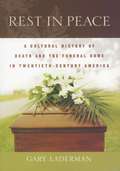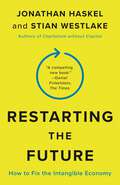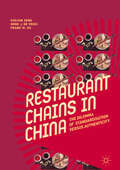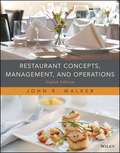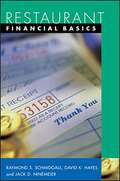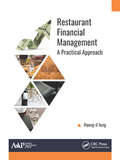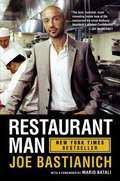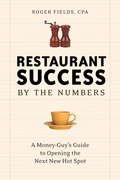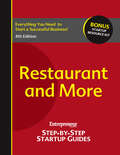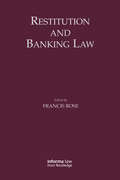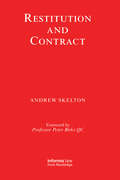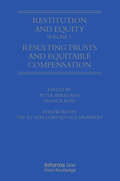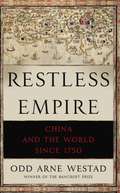- Table View
- List View
Rest in Peace: A Cultural History of Death and the Funeral Home in Twentieth-Century America
by Gary LadermanThough it has often been passionately criticized--as fraudulent, exploitative, even pagan--the American funeral home has become nearly as inevitable as death itself, an institution firmly embedded in our culture. But how did the funeral home come to hold such a position? What is its history? And is it guilty of the charges sometimes leveled against it? In Rest in Peace, Gary Laderman traces the origins of American funeral rituals, from the evolution of embalming techniques during and after the Civil War and the shift from home funerals to funeral homes at the turn of the century, to the increasing subordination of priests, ministers, and other religious figures to the funeral director throughout the twentieth century. In doing so he shows that far from manipulating vulnerable mourners, as Jessica Mitford claimed in her best-selling The American Way of Death (1963), funeral directors are highly respected figures whose services reflect the community's deepest needs and wishes. Indeed, Laderman shows that funeral directors generally give the people what they want when it is time to bury our dead. He reveals, for example, that the open casket, often criticized as barbaric, provides a deeply meaningful moment for friends and family who must say goodbye to their loved one. But he also shows how the dead often come back to life in the popular imagination to disturb the peace of the living. Drawing upon interviews with funeral directors, major historical events like the funerals of John F. Kennedy and Rudolf Valentino, films, television, newspaper reports, proposals for funeral reform, and other primary sources, Rest in Peace cuts through the rhetoric to show us the reality--and the real cultural value--of the American funeral.
Restart: Life Tactics for Today's Economy
by Tom Monte Peter KashOriginal view on what makes for business success, by one of Wall Street's most successful venture capitalists, it shows how to recognize and seize the moment that turns dreams of great fortune into reality.
Restarting the Future: How to Fix the Intangible Economy
by Jonathan Haskel Stian WestlakeFrom the acclaimed authors of Capitalism without Capital, radical ideas for restoring prosperity in today’s intangible economyThe past two decades have witnessed sluggish economic growth, mounting inequality, dysfunctional competition, and a host of other ills that have left people wondering what has happened to the future they were promised. Restarting the Future reveals how these problems arise from a failure to develop the institutions demanded by an economy now reliant on intangible capital such as ideas, relationships, brands, and knowledge.In this groundbreaking and provocative book, Jonathan Haskel and Stian Westlake argue that the great economic disappointment of the century is the result of an incomplete transition from an economy based on physical capital, and show how the vital institutions that underpin our economy remain geared to an outmoded way of doing business. The growth of intangible investment has slowed significantly in recent years, making the world poorer, less fair, and more vulnerable to existential threats. Haskel and Westlake present exciting new ideas to help us catch up with the intangible revolution, offering a road map for how to finance businesses, improve our cities, fund more science and research, reform monetary policy, and reshape intellectual property rules for the better.Drawing on Haskel and Westlake’s experience at the forefront of finance and economic policymaking, Restarting the Future sets out a host of radical but practical solutions that can lead us into the future.
Restartup: A Founder's Guide to Crisis Navigation
by Arunkumar Krishnakumar Maxson J. TeeYour complete startup downturn survival guide During a market boom, startup funding is in abundance. But when a financial crisis hits, investments dry up, making it difficult for newer, smaller outfits to survive. During a period of economic instability, that task might seem even harder. However, a crisis doesn’t have to mean it’s time to shut up shop. Restartup shows how it’s possible—by choosing to embrace instability and seizing the new opportunities it provides—to stay afloat, and even to thrive. Arunkumar Krishnakumar and Maxson Tee —tech investor, influencer, blogger, and podcaster— use case studies and in-depth interviews with VCs, CEOs, and academics to flesh-out anecdotal crisis-survival frameworks. They introduce you to the concepts, tools and techniques to help you sail through an economic storm. The money pyramid—understand your crisis financing options Mental Health – drop the societal taboo for the wellbeing of the company and the founders Fundraising psychology—go beyond the deck and the proposition to get inside your investor’s head Operational efficiencies—know how to cut back but still hold onto your top people Embrace the suck—see how a crisis can open up unexpected opportunities Don’t let a crisis go to waste: stop worrying and use the proven ideas in this book to turn instability into opportunity—and embrace the wild ride to survival and success.
Restating Revenues and Earnings at INVESTools, Inc. (A)
by F. Warren Mcfarlan Michael D. KimbroughRelates the events leading up to the announcement in February 2005 that INVESTools, a Utah-based provider of investor education services, would be restating prior-year financial statements due to inappropriate revenue recognition.
Restating Revenues and Earnings at INVESTools, Inc. (C)
by F. Warren Mcfarlan Michael D. KimbroughAn abstract is not available for this product.
Restaurant Brands International: Version 2.0
by Boris Groysberg Sarah L. AbbottIn 2010, 3G Capital acquired Burger King, the second largest burger chain globally. 3G expanded Burger King's operations via acquisitions into a multi-brand business, renamed Restaurant Brands International. The acquisition had been a financial success story for 3G. However, in recent years RBI had faced its share of challenges including competition in its home markets, the rollout of a digital strategy, and increased employee turnover. In March 2022, the questions facing Jos Cil, RBI's CEO, and the company's co-chairmen, Daniel Schwartz and Alex Behring, were whether they had done the right things to address these challenges and position RBI for continued success and what else needed to be done?
Restaurant Chains in China: The Dilemma Of Standardization Versus Authenticity
by Frank M. Go Guojun Zeng Henk J. de VriesThis book explores the paradox of the hospitality industry: customers demand not only personal and innovative tourism products and services, but also cost-effective ones. Enterprises have the option to meet the former demand by offering authentic products and services while the latter could be achieved through standardization. Although it seems ideal to combine both concepts, they seemingly contradict each other leading to suppliers facing an authenticity-standardization paradox. The authors identify, analyze, and provide solutions for this authenticity-standardization paradox based on a series of case studies of restaurants in China. This book will be of interest to scholars, business owners, and consultants.
Restaurant Concepts, Management, and Operations
by John R. WalkerRestaurant Concepts, Management, and Operations, 8th Edition features comprehensive, applications-based coverage of all aspects of developing, opening, and running a restaurant. This includes topics such as staffing, legal and regulatory concerns, cost control and general financing, marketing and promotion, equipment and design, the menu, sanitation, and concept. A one-stop guide to the restaurant business, the Eighth Edition of Walker's, Restaurant Concepts, Management, and Operations continues the success of previous editions, providing, in an easy-to-read way, all of the skills and information needed to master every challenge and succeed in this highly competitive and rewarding industry. Each chapter has been revised, updated, and enhanced with numerous industry examples, sidebars, charts, tables, photographs, and menus. All of this information will help restaurant owners make the decisions necessary to build a thriving business.
Restaurant Financial Basics
by Raymond S. Schmidgall David K. Hayes Jack D. NinemeierOne of the keys to a successful restaurant business is strong financial management. This volume in the Wiley Restaurant Basics Series provides restaurateurs with the tools necessary to manage their food-based operation by explaining basic accounting principles such as pricing, budgeting, cost control, payroll, and cash flow.
Restaurant Financial Management: A Practical Approach
by Hyung-Il Jung<p>This new book, Restaurant Financial Management: A Practical Approach, provides valuable guidance on how to apply the concepts of accounting and finance to real-life restaurant business activities. This book is unique because it provides an understandable framework that breaks it down into three clear steps of applying techniques of accounting and finance to evaluate a restaurant business: It introduces how to consolidate major activities of a restaurant business into useful accounting information. It explains how accounting information is analyzed and then used to forecast the future. And it introduces the methods of projecting the future and determining the current value of a restaurant business. Using this approach, readers can develop useful knowledge on how to relate accounting and finance to a real-life restaurant business. <p>Using an imaginary restaurant business (based on a real restaurant) as an example to demonstrate a series of relevant business activities, the book walks the reader through provides the restaurant accounting activities and shows how they provide meaningful information, giving the reader a bird’s eye view.</p>
Restaurant Man
by Joe BastianichHow does a nice Italian boy from Queens turn his passion for food and wine into a nationwide empire? In his intrepid, irreverent, and terrifically entertaining memoir, Restaurant Man, Joe Bastianich charts his remarkable culinary journey from his parents' neighborhood eatery to becoming one of the country's most successful restaurateurs, along with his superstar chef partners -- his mother, Lidia Bastianich, and Mario Batali. Joe first learned the ropes of the restaurant business from his father, Felice Bastianich, the original Restaurant Man, the ultrapragmatic and sharp-eyed owner of a popular red-sauce joint. But years of cleaning chickens and other kitchen drudgery convinced Joe that his destiny lay elsewhere. After a year on Wall Street, however, he realized that his love of food was by now too deeply ingrained, and after buying a one-way ticket to Italy, he spent over a year working in restaurants and vineyards there, developing his own taste and learning everything he could about Italian cuisine. Upon his return to New York, he partnered with his mother to open Becco and soon after joined forces with Mario Batali, an alliance that not only created a string of critically acclaimed and popular restaurants but redefined Italian food in America. Restaurant Man is not only a compelling ragù-to-riches chronicle but a look behind the scenes at what it really takes to run a restaurant in New York City, the most demanding, fickle, and passionate market in America, from dealing with shady vendors, avaricious landlords, and vitriolic food critics to day-to-day issues like the cost of linens ("the number-one evil") and bread and butter. Writing vividly in an authentic New York style that is equal parts rock 'n' roll and hard-ass, bottom-line business reality, Joe shares lessons learned from a lifetime spent in restaurants ("Anything you give away for free is bad") while recounting the stories of his own establishments -- including how Del Posto managed to overcome a menu that was initially so ambitious that it could not be executed, to ultimately become the only Italian restaurant in America to be awarded four-stars from The New York Times. Joe speaks frankly about friends and foes, but at the heart of the book is the mythical hero Restaurant Man, the old-school, blue-collar guy who stays true to the real secret of his success -- watching costs but ferociously dedicating himself to exceeding his customers' expectations and delivering the best dining experience in the world.
Restaurant Man
by Joe Bastianich"The best, funniest, most revealing inside look at the restaurant biz since Anthony Bourdain's Kitchen Confidential." --Jay McInerney With a new foreword by Mario Batali Joe Bastianich is unquestionably one of the most successful restaurateurs in America--if not the world. So how did a nice Italian boy from Queens turn his passion for food and wine into an empire? In Restaurant Man, Joe charts a remarkable journey that first began in his parents' neighborhood eatery. Along the way, he shares fascinating stories about his establishments and his superstar chef par tners--his mother, Lidia Bastianich, and Mario Batali. Ever since Anthony Bourdain whet literary palates with Kitchen Confidential, restaurant memoirs have been mainstays of the bestseller lists. Serving up equal parts rock 'n' roll and hard-ass business reality, Restaurant Man is a compelling ragu-to-riches chronicle that foodies, businessmen, and aspiring restauranteurs alike will be hankering to read.
Restaurant Promotions in 2015
by Benjamin EdelmanA variety of services offer consumers discounts when dining at participating restaurants. This case examines four such services: Entertainment Book, Restaurant.com, Rewards Network, and Groupon. Despite key functional similarities, each of the services chooses an importantly different approach-different pricing, different benefits to consumers, different benefits to restaurants, and different underlying technologies.
Restaurant Success by the Numbers
by Roger FieldsNinety percent of all restaurants fail, and those that succeed happened upon that mysterious X factor, right? Wrong! A man of many hats-money-guy, restaurant owner, and restaurant consultant-Roger Fields shows how a restaurant can survive its first year, based on far more than luck, and keep diners coming back for many years to come. Featuring real-life restaurant start-up stories (including some of the author'¬?s own), this comprehensive how-to walks readers through the logistics of opening a restaurant: creating the concept, choosing a location, designing the menu, establishing ambiance, hiring staff, and, most important, turning a profit. Opening a restaurant isn'¬?t easy, but this realistic dreamer'¬?s guide helps set the table for lasting success.From the Trade Paperback edition.
Restaurant Success by the Numbers, Second Edition: A Money-Guy's Guide to Opening the Next New Hot Spot
by Roger FieldsThis one-stop guide to opening a restaurant from an accountant-turned-restaurateur shows aspiring proprietors how to succeed in the crucial first year and beyond.The majority of restaurants fail, and those that succeed happened upon that mysterious X factor, right? Wrong! Roger Fields--money-guy, restaurant owner, and restaurant consultant--shows how eateries can get past that challenging first year and keep diners coming back for more. The only restaurant start-up guide written by a certified accountant, this book gives readers an edge when making key decisions about funding, location, hiring, menu-making, number-crunching, and turning a profit--complete with sample sales forecasts and operating budgets. This updated edition also includes strategies for capitalizing on the latest food, drink, and technology trends. Opening a restaurant isn't easy, but this realistic dreamer's guide helps set the table for lasting success.
Restaurant and More
by Entrepreneur MagazineRestaurant sales are expected to hit $511 billion this year. More people than ever are dining out. Average Joes are becoming "foodies" after exposure to the celebrity chefs and exotic ingredients on TV's Food Network. Busy consumers don't have the time or inclination to cook--they want the flavor of fresh bread without the hassle of baking. They want tasty, nutritious meals without dishes to wash. More and more singles, working parents and seniors are demanding greater convenience in buying their meals and are turning to operations that provide that convenience. As you can see, there's never been a better time to open up your own restaurant.In this extensive guide, you learn the latest food trends, what the competition looks like, how to research your potential customers, the basics of setting up a dining room and kitchen, how to find a great location, how to leap over regulatory hurdles in the industry, and how to find the best people to staff your business.Here's everything you need to consider when starting your own restaurant, pizzeria, coffeehouse, delicatessen, bakery, or catering business. Among the many topics covered are:Set-up equipmentInventoryStaffingLegal structureLocationPermitsSanitationMarketingFinancial managementThis guide is fully updated with the newest trends in menu items, decor and themes, plus recent market statistics and forecasts. Interviews with successful eatery owners show how others have made their food business dreams come true. So whether you decide to keep it simple with a sandwich-and-salad operation, dazzle event guests with your catered cuisine, create a cozy neighborhood java joint, or make a splash with a four-star bistro, we've got the information you need to be a success.The First Three YearsIn addition to industry specific information, you'll also tap into Entrepreneur's more than 30 years of small business expertise via the 2nd section of the guide - Start Your Own Business. SYOB offers critical startup essentials and a current, comprehensive view of what it takes to survive the crucial first three years, giving your exactly what you need to survive and succeed. Plus, you'll get advice and insight from experts and practicing entrepreneurs, all offering common-sense approaches and solutions to a wide range of challenges. Pin point your target market Uncover creative financing for startup and growth Use online resources to streamline your business plan Learn the secrets of successful marketing Discover digital and social media tools and how to use them Take advantage of hundreds of resources Receive vital forms, worksheets and checklists From startup to retirement, millions of entrepreneurs and small business owners have trusted Entrepreneur to point them in the right direction. We'll teach you the secrets of the winners, and give you exactly what you need to lay the groundwork for success.BONUS: Entrepreneur's Startup Resource Kit!Every small business is unique. Therefore, it's essential to have tools that are customizable depending on your business's needs. That's why with Entrepreneur is also offering you access to our Startup Resource Kit. Get instant access to thousands of business letters, sales letters, sample documents and more - all at your fingertips!You'll find the following:The Small Business Legal ToolkitWhen your business dreams go from idea to reality, you're suddenly faced with laws and regulations governing nearly every move you make. Learn how to stay in compliance and protect your business from legal action. In this essential toolkit, you'll get answers to the "how do I get started?" questions every business owner faces along with a thorough understanding of the legal and tax requirements of your business.Sample Business Letters1000+ customizable business letters covering each type of written business communication you're likelyto encounter as you communicate with customers, suppliers, employees, and others. Plus a complete guide to business communication that covers every question you may have about developing your own business communication s...
Restitution and Banking Law
by Francis D RoseRestitution and Banking Law, written by leading practitioners and commentators, combines their experience in the field of restitution law and banking law to discuss major issues.
Restitution and Contract
by Andrew SkeltonA comprehensive review of the practical implications of the numerous recent cases on swaps and derivatives.
Restitution and Equity Volume 1: Resulting Trusts and Equitable Compensation
by Peter Birks and Francis RoseThe first part of this volume collates papers from the Second Mansfield Symposium, which examined the areas of equity, trusts and restitution. The second part addresses the emerging field of equitable compensation and its implications.
Restitution and European Community Law
by Alison JonesThe growth in prominence of the law of restitution and European Community law has resulted in the creation of a body of case law, which is contained within this work. This book examines the Community rules that affect restitutionary claims commenced in the English courts. This book considers the affect that EC rules may have on the development of specific areas of the English law of restitution, it sets out the circumstances in which the development of English rules governing restitutionary claims might be affected by the requirements of Community law, and examines in detail the Community rules which affect restitutionary claims commenced before the national courts and attempts to rationalise and to explain them within the framework of the principle of unjust enrichment.It is essential reading for practitioners as well as academics and postgraduate students.
Restless Continent: Wealth, Rivalry and Asia's New Geopolitics
by Michael WesleyAn essential road map to modern Asia&’s dynamic transition on the world stage from the foreign policy expert and author of There Goes the Neighbourhood. The world has never seen economic development as rapid or significant as Asia&’s during recent decades. Home to three-fifths of the global population, this restless continent will soon produce more than half of the world&’s economic output and consume more energy than the rest of the world combined. All but three of the planet&’s current and nascent nuclear powers are Asian, and it has the greatest growth in weapons spending of any other region. Yet, surprisingly little has been written about the future of Asia. Restless Continent is the first book to examine the economic, social, political, and strategic trends across the world&’s largest continent, providing the necessary framework for thinking about the future of Asia—and the world. A professor of international affairs at Australian National University, Michael Wesley looks at the psychology of Asian countries becoming newly rich and powerful. He explores the geography and politics of conflict, and offers persuasive ideas about how to avert dispute, or even war. Written for general readers and policy specialists alike, Restless Continent is an agenda-shaping book about international affairs in the twenty-first century.
Restless Empire: China and the World Since 1750
by Odd Arne WestadOver the past 250 years of momentous change and dramatic upheaval, China has proved itself to be a Restless Empire. Tracing Chinaâe(tm)s course from the eighteenth-century Qing Dynasty to today's Peopleâe(tm)s Republic, Restless Empire shows how the countryâe(tm)s worldview has evolved. It explains how Chinese attitudes have been determined by both receptiveness and resistance to outside influence and presents the preoccupations that have set its foreign-relations agenda. Within two decades China is likely to depose the United States as the worldâe(tm)s largest economy. By then the country expects to have eradicated poverty among its population of more than one and a half billion, and established itself as the worldâe(tm)s technological powerhouse. Meanwhile, some âe" especially its neighbours âe" are afraid that China will strengthen its military might in order to bend others to its will. A new form of Chinese nationalism is rising. Many Chinese are angry about perceived past injustices and fear a loss of identity to commercial forces and foreign influences. So, will Chinaâe(tm)s attraction to world society dwindle, or will China continue to engage? Will it attempt to recreate a Sino-centric international order in Eastern Asia, or pursue a more harmonious diplomatic route? And can it overcome its lack of democracy and transparency, or are these characteristics hard-wired into the Chinese system? Whatever the case, we ignore Chinaâe(tm)s international history at our peril. Restless Empire is a magisterial and indispensible history of the most important state in world affairs today. WINNER OF THE 2013 ASIA SOCIETY BERNARD SCHWARTZ BOOK AWARD
Restorative Community Justice: Repairing Harm and Transforming Communities
by Gordon Bazemore Mara SchiffAn anthology of original essays, this book presents debates over practice, theory, and implementation of restorative justice. Attention is focused on the movement’s direction toward a more holistic, community-oriented approach to criminal justice intervention.
Restorative Just Culture in Practice: Implementation and Evaluation
by Sidney Dekker, Joseph Rafferty and Amanda OatesA restorative just culture has become a core aspiration for many organizations in healthcare and elsewhere. Whereas ‘just culture’ is the topic of some residual conceptual debate (e.g. retributive policies organized around rules, violations and consequences are ‘sold’ as just culture), the evidence base on, and business case for, restorative practice has been growing and is generating increasing, global interest. In the wake of an incident, restorative practices ask who are impacted, what their needs are and whose obligation it is to meet those needs. Restorative practices aim to involve participants from the entire community in the resolution and repair of harms. This book offers organization leaders and stakeholders a practical guide to the experiences of implementing and evaluating restorative practices and creating a sustainable just, restorative culture. It contains the perspectives from leaders, theoreticians, regulators, employees and patient representatives. To the best of our knowledge, there is no book on the market today that can function as a guide for the implementation and evaluation of a just and learning culture and restorative practices. This book is intended to fill this gap. This book will provide, among other topics, an overview of restorative just culture principles and practices; a balanced treatment of the various implementations and evaluations of just culture and restorative processes; a guide for leaders about what to stop, start, increase and decrease in their own organizations; and an attentive to philosophical and historical traditions and assumptions that underlie just culture and restorative approaches. The interest in ‘just culture’, not just in healthcare but also in other fields of safety-critical practice, has been steadily growing over the past decade. It is a trending area. In this, it has become clear that 20-year-old retributive models not only hinder the acceleration of performance and organizational improvement but have also in some cases become a blunt HR instrument, an expression of power over justice and a way to stifle honesty, reporting and learning. What is new in this, then, is the restorative angle on just culture, as it has been developed over the last few years and now is practised and applied to HR, suicide prevention, healthcare improvement, regulatory innovations and other areas.
